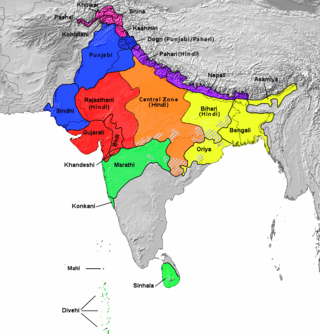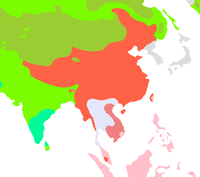South Asian ethnic groups
The ethno-linguistic composition of the population of South Asia, that is the nations of India, Pakistan, Afghanistan, Bangladesh, Nepal, Bhutan, Maldives and Sri Lanka is highly diverse.[1] The majority of the population fall within two large linguistic groups, Indo-Aryan and Dravidian.[2] Indian society is traditionally divided into castes or clans, not ethnicities, and these categories have had no official status since independence in 1947, except for the scheduled castes and tribes which remain registered for the purpose of affirmative action. In today's India, the population is categorized in terms of the 1,652 mother tongues spoken.

These groups are further subdivided into numerous sub-groups, castes and tribes. Indo-Aryans form the predominant ethno-linguistic group in Northern India, Bangladesh, Pakistan, Nepal, Sri Lanka and the Maldives. Dravidians form the predominant ethno-linguistic group in southern India and the northern and eastern regions of Sri Lanka, and a small pocket in Pakistan. Certain Iranian speaking peoples also have a significant presence in South Asia, the large majority of whom are located in Pakistan, with heavy concentrations in Balochistan, Khyber-Pakhtunkhwa and Federally Administered Tribal Areas. Dardic peoples form a minority among the Indo-Aryans. They are classified as belonging to the Indo-Aryan language group,[3] though sometimes they are also classified as external to the Indo-Aryan branch.[4] They are found in northern Pakistan (Northern Areas and Khyber-Pakhtunkhwa) and in Jammu and Kashmir, India.
Minority groups not falling within either large group mostly speak languages belonging to the Austroasiatic and Tibeto-Burman language families, and mostly live around Ladakh and Northeast India, Nepal, Bhutan, and the Chittagong Division of Bangladesh. The Andamanese (Sentinel, Onge, Jarawa, Great Andamanese) live on some of the Andaman Islands and speak a language isolate, as do the Kusunda in central Nepal,[5] the Vedda in Sri Lanka, and the Nihali of central India, who number about 5000 people. The people of the Hunza valley in Pakistan are another distinct population. They speak Burushaski, a language isolate.
The traditions of different ethnic groups in South Asia have diverged, influenced by external cultures, especially in the northwestern parts of South Asia (where Turkic and Iranian peoples have had much influence) and in the border regions and busy ports, where there are greater levels of contact with external cultures. This is particularly true for many ethnic groups in the northeastern parts of South Asia who are ethnically related to peoples of the Far East. The largest ethno-linguistic group in South Asia are the Indo-Aryans, numbering around 1 billion, and the largest sub-group are the native speakers of Hindi languages, numbering more than 470 million.
These groups are based solely on a linguistic basis and not on genetic basis.
List of ethnic groups on the basis of language
Indo-Aryan
People who speak an Indo-Aryan language.

Most of the North Indian and Nepalese population is of partial Indo-Aryan descent. The Ra1a1 gene haplotype is found in at least 50% of the populations from North/East India to Central Asia and Eastern Europe.
- Assamese people (i.e. the Assamese speakers of the Brahmaputra valley, not to be confused with the multi-ethnic people of Assam)[6]
- Bengali people
- Bihari people
- Dhivehi people
- Gujarati people
- Saurashtra people
- Konkani
- Marathi people
- Muhajir people
Iranian peoples
Dardic peoples
The Dardic languages are largely seen as Indo-Aryan, but are sometimes seen as a separate Indo-Iranian branch.
Dravidian peoples
- Badagas
- Bhil
- Bonda
- Brahui people
- Dongria Kondha
- Gondi people
- Irulas
- Kannadigas
- Khonds
- Kodava
- Kurukh (Oraon)
- Malayali
- Mappilas Muslims of North Kerala comprising two groups
- a group which has partial Persian/Arab ancestry through traders but speaks Dravidian language Malayalam
- a group which includes converts to Islam from north Kerala native Hindus
- Muslims of South Kerala which includes converts from native Hindus
- Syrian Malabar Nasrani
- Mappilas Muslims of North Kerala comprising two groups
- Malto people
- Tamil people
- Telugu people
- Toda people
- Tuluvas
Austroasiatic peoples
Tibeto-Burman peoples

- Ethnic Assamese (people of Tibeto-Burman pure and mixed ancestry speaking Assamese as their Mother tongue)
- Tibetans and Tibetan-speaking peoples
- Bodo-Kachari people
- Chakma
- Nepalese people or Gurkha
- Manipuri or Meithei people
- Naga people
- Karbi people or Mikir
- Thami
- Tripuris
- Memba
- Khowa
- Nishi
Turko-Mongol peoples
- Turkish Indian
- Mughal (Moghul) (A great Sunni Islamic dynasty of Asia which originated in Central Asia)
- Chughtai Tartars (Those people who originated in Uzbekistan and fought for Chagatai Khan who was son of Genghis Khan).
- Barlas (A Turkified Mongol Tribe to which Babur belonged)
- Qizilbash
- Changezi (Those who were in army of Hulagu Khan)
- Hazaras (Turko-Mongol origins, but Iranic language)
Austronesian peoples
Semitic peoples
- Arabs or mixed Arab and Indo-Aryan or Dravidian
- Arabs in Gujarat
- Mappila (( Muslims of Malabar(North Kerala)- ancestry to Southern Arab people or Persian traders who intermarried Nair/ Menon /Nambiar (upper class descents) or Thiyya /Mukkuva(lower class descents) of Hindu community of North Kerala))
- Sri Lankan Moors ( trace ancestry to Arab traders who settled in Sri Lanka)
- Muhajirs
- Iraqi biradri A community of Muslims in north India (trace ancestry from Arab tribe of Bani Tamim)
- Dakhini Muslims A community of Muslims in Southern and Northern parts of the Deccan Plateau such as the Hyderabadi Muslim community.
- Labbay Arab traders who settled in South India
- Rowther Muslims of Tamil Nadu and Kerala who descended from Turkish traders and soldiers from the expedition of Sindh.
- Boras Trace ancestors to Arab traders and Merchants.
- Chaush Trace ancestors to traders from Yemen
- Indian Jews
- Cochin Jews (Malayali Jews)
- Bene Israel (Marathi Jews)
- Baghdadi Jews (Arab Jews in Bengal)
- Bnei Menashe (Mizo and Kuki Jews)
- Bene Ephraim (Telugu Jews)
- Syrian Malabar Nasranis are descendents of both Hindu and Jewish converts to Christianity
- Paradesi Jews (European Jews in India)
Tai peoples
- Ahom people
- Tai Aiton
- Tai Khamti
- Tai Phake or Tai Phakial
- Tai Turung
- Tai Khamyang
European and Eurasian peoples
Afro-Asian
- African Pakistani
- Chaush
- Sheedis/Siddis, an ethnic community of Black African descent
- Siddi
- Siddis of Karnataka, an ethnic community of Black African descent
- Sri Lanka Kaffirs
Andamanese and Nicobarese Groups
- Great Andamanese of the Andaman and Nicobar Islands
- Jangil of the Andaman and Nicobar Islands
- Jarawa of the Andaman and Nicobar Islands
- Onge of the Andaman and Nicobar Islands
- Sentinelese of the Andaman and Nicobar Islands
Linguistically isolate groups
Diaspora
Many South Asian ethnic groups and nationalities have substantial diasporas outside of South Asia.
- South Asian American
- South Asian Canadian
- British Asian
- South Asian Australian
- Indo Kiwi
- Indians in Singapore
- Nepalis in Singapore
- Malaysian Indian
- Nepalese people in Malaysia
- Indian Indonesian
- Indo-Mauritian
- Indo-Caribbean
- Burmese Indians
- South Asians in Hong Kong
- South Asians in the Philippines
- Indians in Germany
- Nepalis in Germany
- Indian South Africans
- Indians in Botswana
- Indians in Kenya
- Indians in Madagascar
- Indo-Mauritian
- Indians in Mozambique
- Indo-Réunionnaise
- Indo-Seychellois
- Indians in Tanzania
- Indians in Uganda
- Indians in Zambia
- Indians in Zimbabwe
- Indians in Iran
- Indians in Thailand
- Indians in the United Arab Emirates
- Indians in Vietnam
- Indians in Barbados
- Indians in Belize
- Indo-Guyanese
- Indo-Grenadians
- Indians in Guadeloupe
- Indians in Panama
- Indians in Belgium
- Indian diaspora in France
- Indians in Israel
- Indians in Italy
- Indians in Portugal
- Indian community in Spain
- Indo-Surinamese
- Indo-Fijian
- Indians in New Caledonia
See also Punjabi diaspora, Bangladeshi diaspora, Tamil diaspora, Pakistani diaspora, Sri Lankan Tamil diaspora, Nepalese diaspora and Indian diaspora.
Two (or possibly three) other people groups have ethnic and linguistic ties with the region:
- Dom people
- Romani people
- Lom people (who speak a language both related to Indo-Aryan and Armenian)
See also
- Languages of South Asia
- Genetics and Archaeogenetics of South Asia
- Y-DNA haplogroups in South Asian populations
- Historical definitions of races in India
- Languages of India
- Languages of Nepal
- Scheduled castes and scheduled tribes
- Indian diaspora
- Nepalese Diaspora
- Pakistani diaspora
- Desi
- Languages of Nepal
- Languages of Pakistan
- Ethnic groups in Pakistan
- Nepalese people
- Assamese people
- Sikkimese people
National demographics:
- Demographics of Afghanistan
- Demographics of Bangladesh
- Demographics of Bhutan
- Demographics of India
- Demographics of Maldives
- Demographics of Burma
- Demographics of Nepal
- Demographics of Pakistan
- Demographics of Sri Lanka
References
- ↑ "UN Geoscheme".
- ↑ Cia.gov Retrieved on October 2010
- ↑ G. Morgenstierne Irano-Dardica. Wiesbaden 1973; Morgenstierne, G. Indo-Iranian frontier languages. (Instituttet for Sammenlignende Kulturforskning. Publ. ser. B: Skrifter, no. 11, 35, 40) Oslo: H. Aschehoug, 1929 sqq, reprint Oslo 1973,C. Masica The Indo-Aryan languages, New York 1991, p. 21; R.L. Trail and G.R. Cooper, Kalasha Dictionary, Islamabad & High Wycombe 1999 p. xi; The Indo-Aryan languages, edited by George Cardona and Dhanesh Jain. London, New York : Routledge, 2003
- ↑ G.A. Grierson, The Pisaca Languages of North-Western India,Asiatic Society, London, 1906, repr. Delhi 1969, p. 4-6; still repeated in: History of Civilizations of Central Asia, Ahmad Hasan Dani, Vadim Mikhaĭlovich Masson, János Harmatta, Boris Abramovich Litvinovskiĭ, Clifford, 1999
- ↑ D.E. Watters, Notes on Kusunda (a language isolate of Nepal), Kathmandu 2005
- ↑ Yasmin Saikia (2004-11-09). Fragmented Memories. ISBN 0822333732.
External links
![]() Media related to Ethnic groups in India at Wikimedia Commons
Media related to Ethnic groups in India at Wikimedia Commons
![]() Media related to Ethnic groups in Pakistan at Wikimedia Commons
Media related to Ethnic groups in Pakistan at Wikimedia Commons